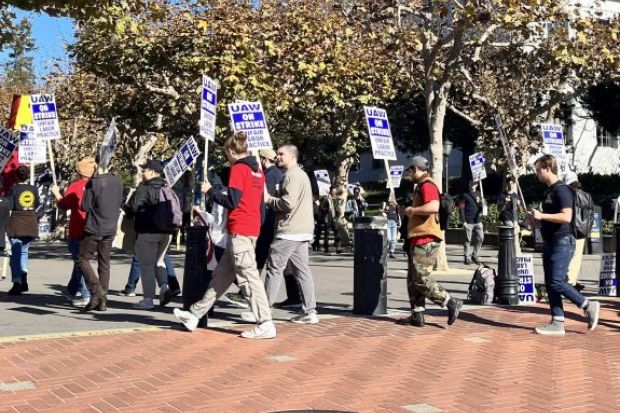Hundreds of University of California faculty have pledged to join a strike by teaching and research assistants, as the 300,000-student system returned from its Thanksgiving holiday break with no sign of an end to the two-week-old walkout.
“The university doesn’t work unless we all work,” a coalition of faculty organisers said in announcing a signed commitment by tenured and tenure-track faculty across the 10-campus system “both to honour the picket line in full and not to replace struck labour”.
Nearly 48,000 California teaching assistants, graders, research assistants and other academic staff began the strike on 14 November, seeking improvements in wages, benefits and better working conditions at the nation’s top-ranked collection of state institutions.
It is the biggest-ever job action in US higher education, with much of the financial stress centring on the high cost of living around most California campuses, in part because of the local economic success such institutions generate and cultivate.
Classes for the University of California’s autumn semester end this week, with final exams the following week, and the walkout has caused widespread stress among students trying to complete their work amid a mix of cancelled classes, missing instructors and emotional questions about how to handle on-campus picket lines.
By publicly aligning themselves with the strikers, supportive faculty are hoping to give students and the wider community clearer and more unified expectations for how the walkout will proceed, said one organiser, Annie McClanahan, an associate professor of English at the University of California, Irvine.
“It’s forcing people to think really hard about these questions and about what it means to honour a picket line, morally and politically,” Dr McClanahan said.
Yet she acknowledged that the 300 signers of the solidarity pledge are a fraction of the California system’s tenured and tenure-track faculty.
“Disruptions across our campuses have been minimal,” said a spokesman for the California system.
And in an apparent response to the new commitment by some faculty to back the strike, system leaders wrote to them warning that anyone failing to teach their classes or otherwise perform their jobs would be docked pay. No firm decision on suspending faculty pay has been made yet, although university leaders “may be communicating with faculty on these issues”, the spokesman said.
California leaders also are facing pressures from the California Public Employment Relations Board, a quasi-judicial state agency that oversees collective bargaining laws, which has filed at least seven complaints against the system over its treatment of the union representing the striking workers. The complaints cover such allegations as improperly withholding information, and revising pay outside of negotiations, setting the stage for a judge to decide if any laws were broken.
The striking workers consist of four groups: 19,000 teaching assistants, tutors and graduate students involved in teaching and grading; 17,000 student researchers, 7,000 postdoctoral researchers and 5,000 academic scientists.
They are part of a nationwide reality in which the compensation for such labour often is seen as not matching the local cost of living. The predicament is especially acute in California and its many high-cost cities. The worker demands include raises combined with additional annual adjustments tied to inflation rates and local housing costs.
But the California system has argued that it could not make realistic financial plans if it had to react to shifts in local housing costs. “Rental rates for non-UC housing vary across the state, and the university has no ability to control or predict rates charged by private landlords and companies,” system leaders said in a statement.
The pay proposals already offered by the system, the California leaders said, would place the university’s graduate students and academic employees “at the top of the pay scale across major public universities and on par with top private universities”.
Register to continue
Why register?
- Registration is free and only takes a moment
- Once registered, you can read 3 articles a month
- Sign up for our newsletter
Subscribe
Or subscribe for unlimited access to:
- Unlimited access to news, views, insights & reviews
- Digital editions
- Digital access to THE’s university and college rankings analysis
Already registered or a current subscriber? Login








